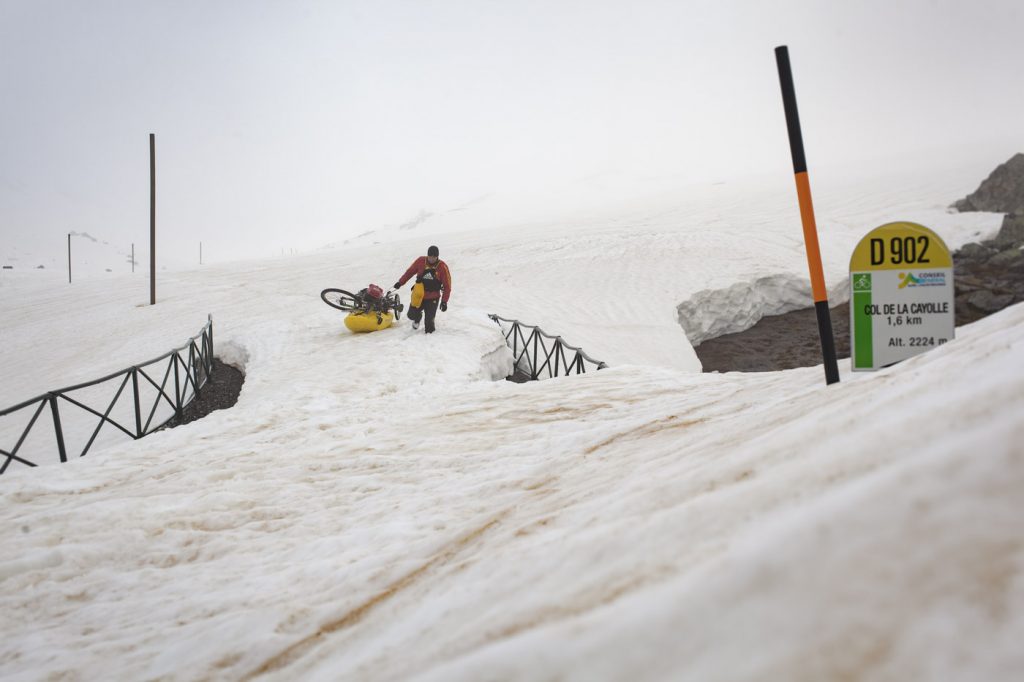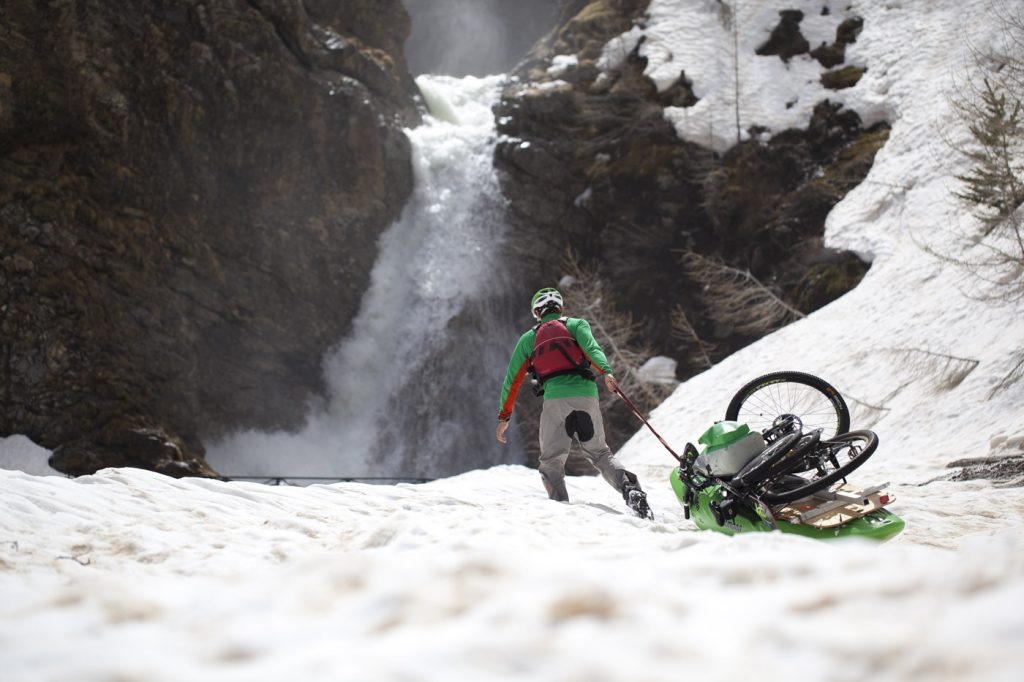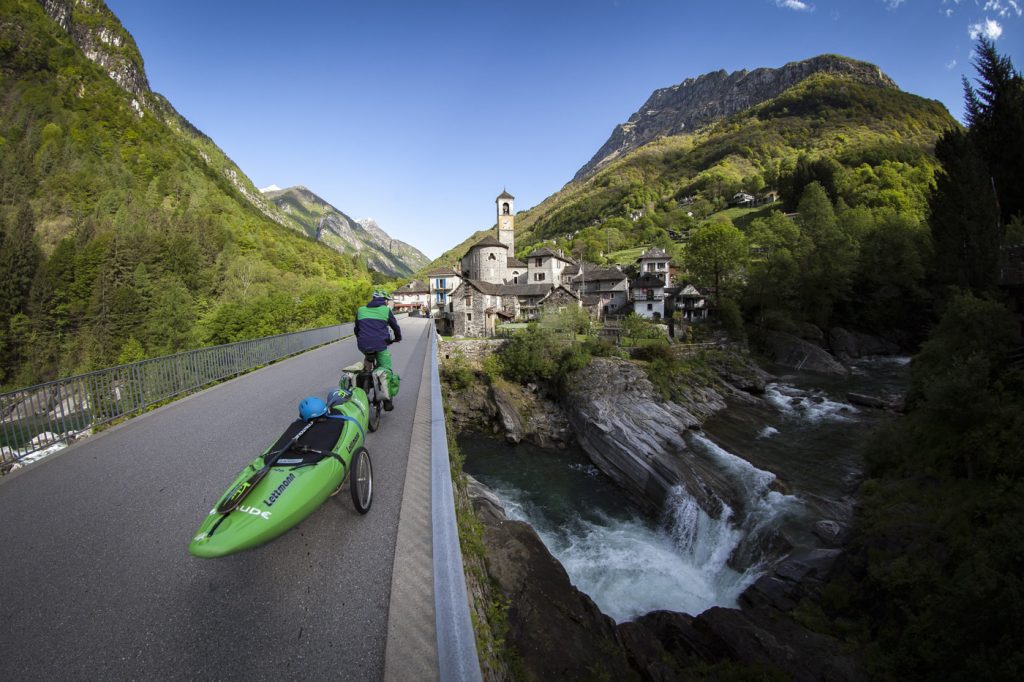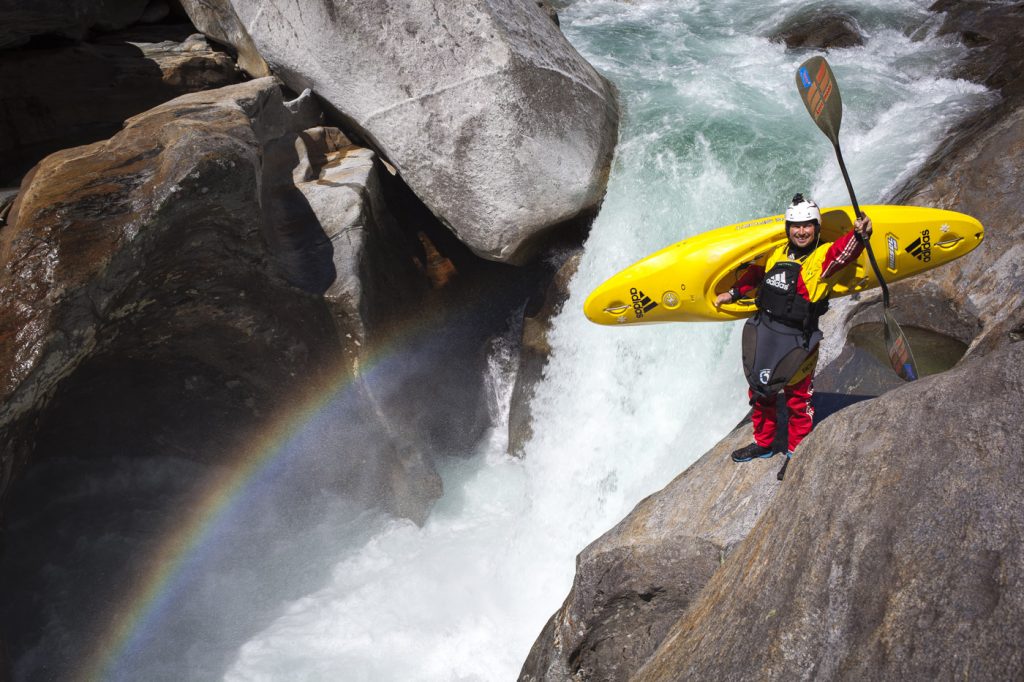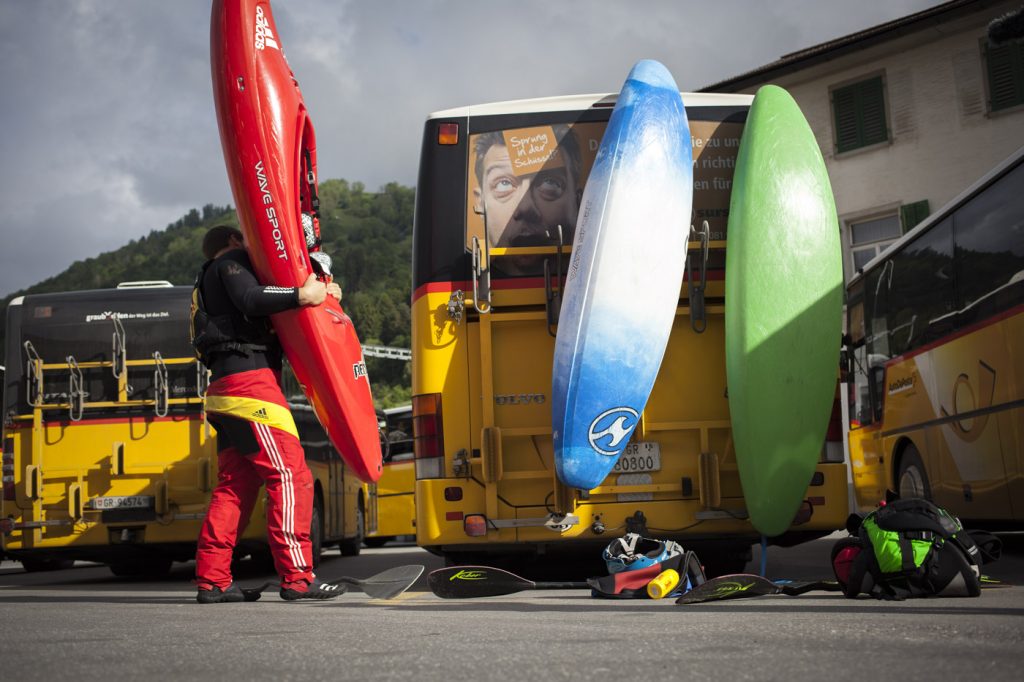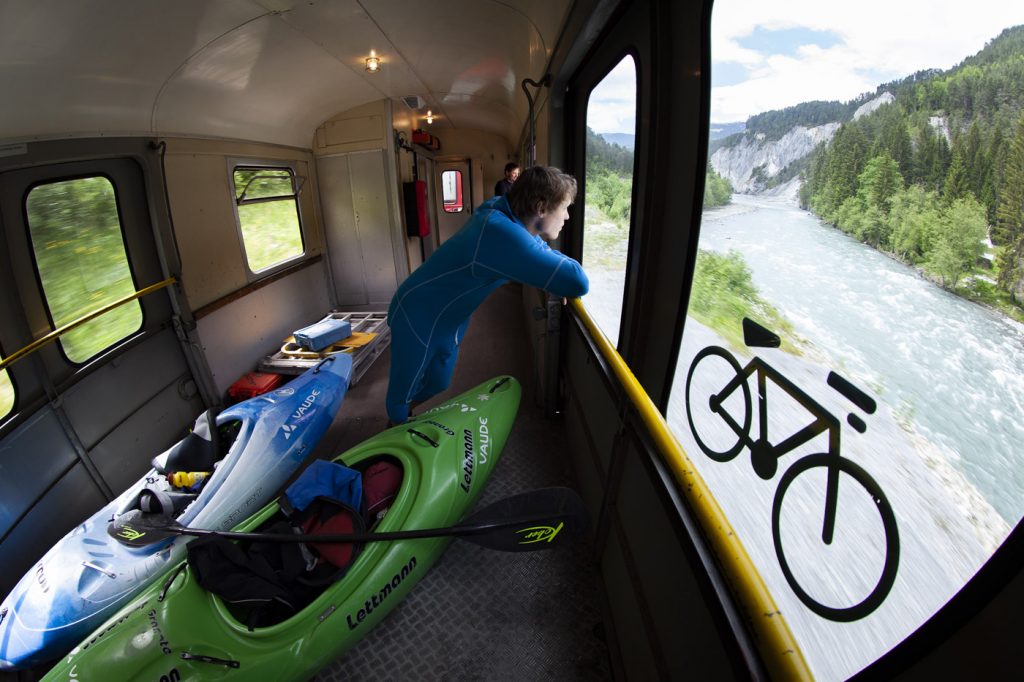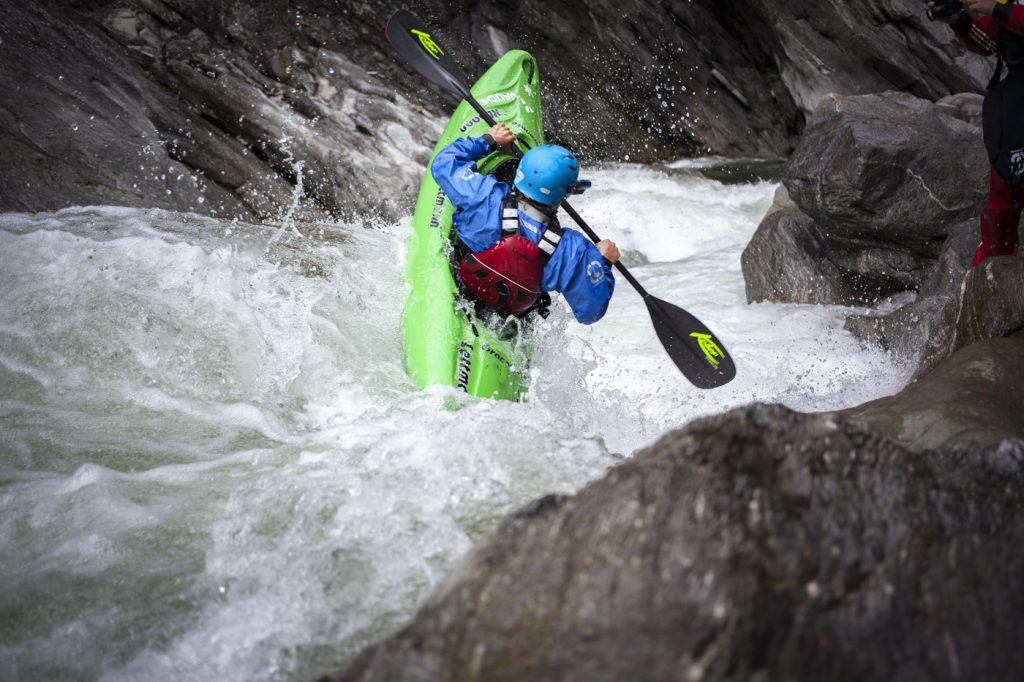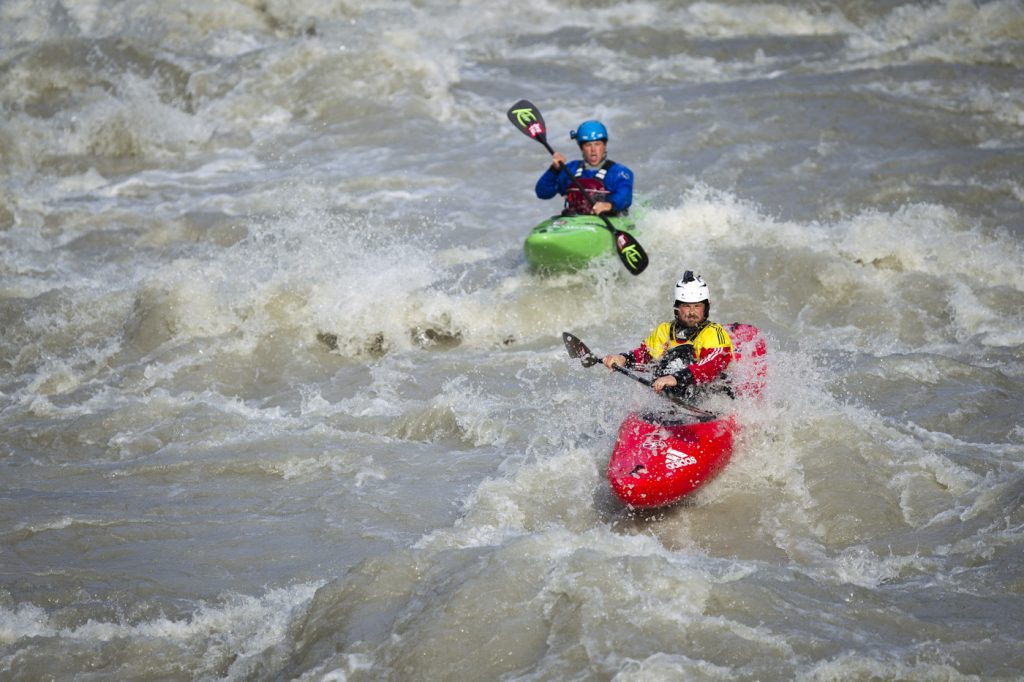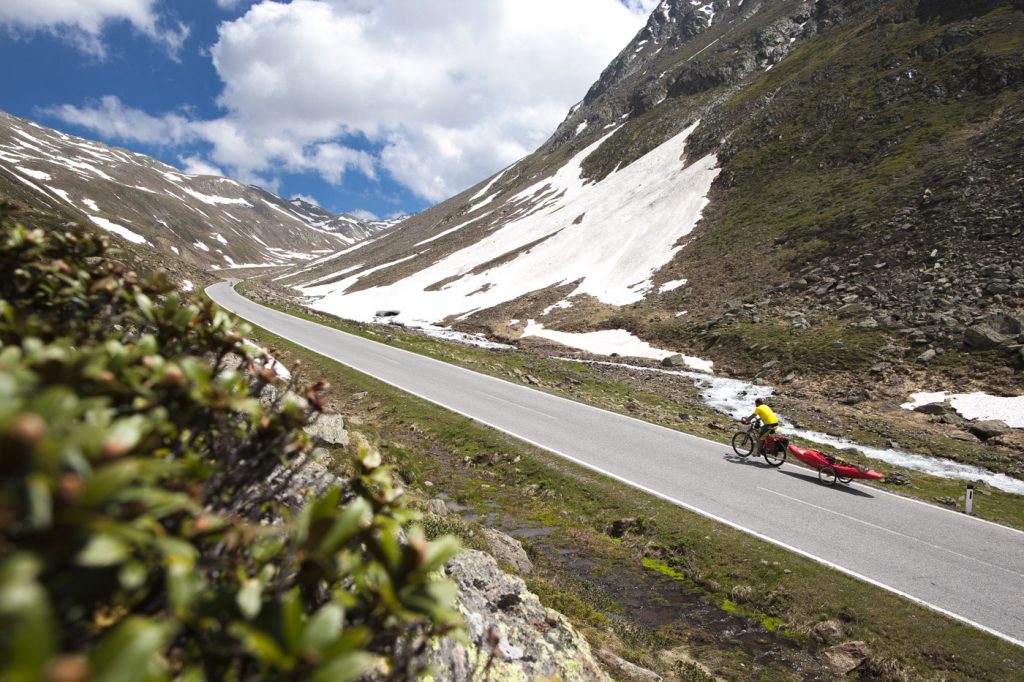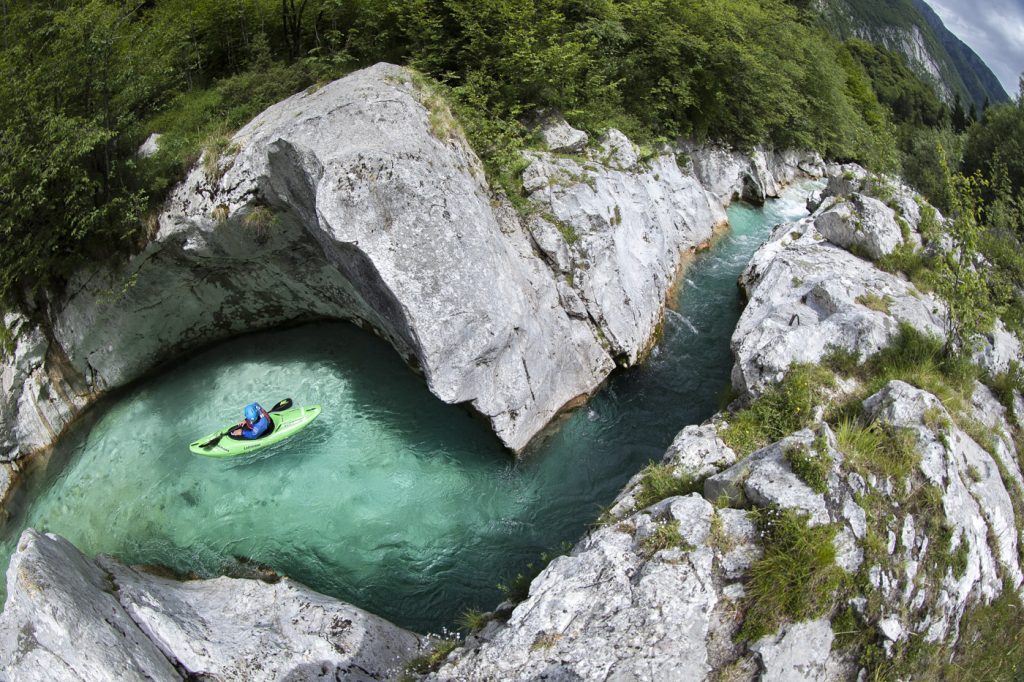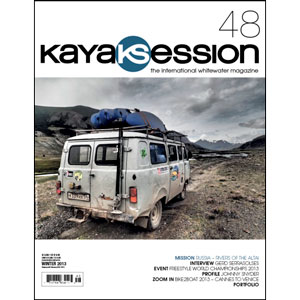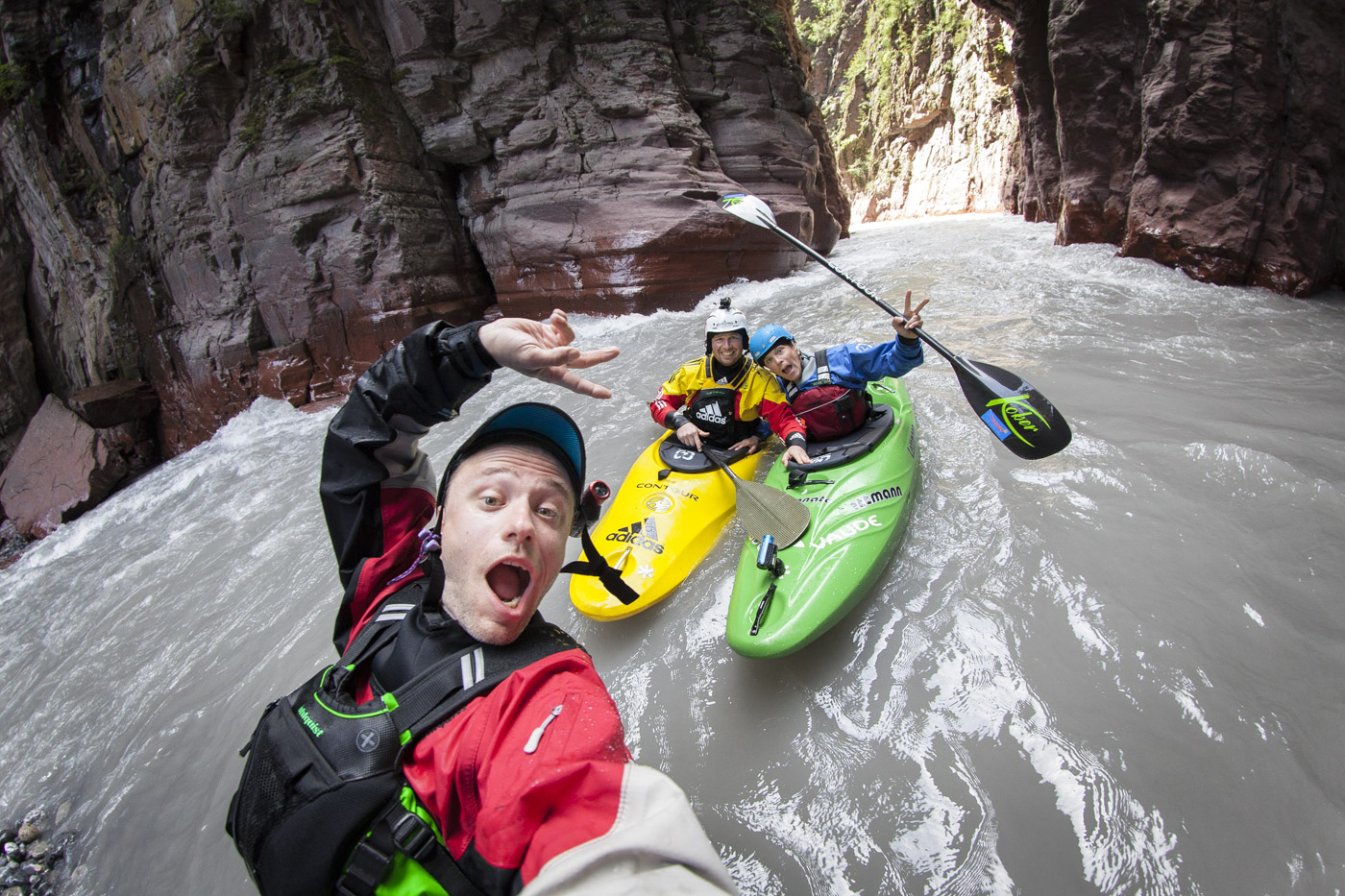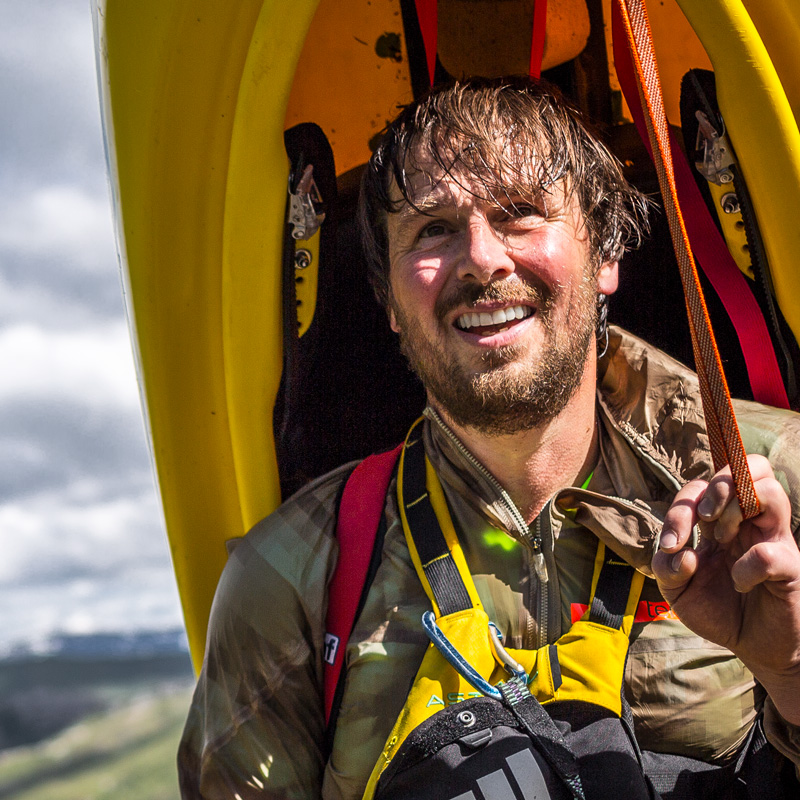Come hell or high water
The crazy Germans are back! After their 2012 Bike2Boat trip through Norway, the crew decided to step up their game. Pedaling from Cannes and Venice they dipped in and out of the wild waters of Central Europe. Despite being farther south than their previous trip, they could have replaced bikes with skis on a few occasions.
Words: Philip Baues – Photos: Jens Klatt
For the first time I think about giving up at Col de la Cayolle in the French Maritime Alps. I am stuck in the snow hip-deep, with one hand trying to push myself out with the other holding the rope with which I drag my kayak behind me like a pulka. I have strapped the bike on top and every few meters the whole setup begins to totter. As I struggle to make any forward progress at all, I’ve suddenly had enough: I scream out every four-letter word I know and even create a couple of new ones.
But it’s no use moaning. For one thing we somehow have to get over that mountaintop and for another thing it is our own fault. From the first moment we had arrived in the Var River Valley, huge “Col fermé” signs pointed out that the first big mountain pass on our trip would be closed due to a big snow pack. But it was 30 °C in the valley and we were sure it would be blocked just for cars if at all. After paddling through the Gorges du Daluis we had to make a decision. Should we turn around and make a detour of several days or should we face the challenge? Being no sissies the answer was clear…
So we find ourselves pedaling up the narrow road in the lowest gear, pulling the 50+ kilos of equipment behind us on the trailer. And the higher we get the more we doubt our plan. At first the valley dwellers are cheering us with shouts of “Allez! Allez!” but eventually they just look disbelievingly and the shouts change to “C’est impossible! La neige !” So what about the snow? We fool ourselves into thinking we know more than the locals. At 2000 meters it starts to rain; shortly after, the rain changes to snow. And then suddenly the road ends. It’s not just some avalanche debris, what we face here looks like the perfect freeride resort. But as I don’t have my skis with me I just feel stupid. It will be dark in about an hour and to turn back is not an option – not least because of our pride. After trying and failing to push our bikes through the snow we decide to use our kayaks as a sledge with trailer and bike on top and luckily there is a small shelter in the basin on top of the pass. Once we’re sitting in our little hideaway with our wet stuff drying by the fire the whole mission seems to be pretty cool again. Hadn’t we been asking for adventure?
The next morning the alarm goes off at 5:30. One view out the window is enough and I just want to crawl back into my sleeping bag: Heavy fog is turning the world grey and drab. Only the snow poles marking the road finally guide us down the far side into the valley below.
Kilometers and calories
The weather in France is perfect but all the rivers are raging because of the strong snowmelt. So we just paddle the Var and the Guil and decide to head to Italy. We pass Briançon, climb up the Col d’Echelle and roll down to Bardonecchia. Halfway between there and Turin it starts raining and doesn’t stop for a week. We do have proper equipment but at some point even your boxers are soaking wet and you are just praying for the rain to stop. At the Lago Maggiore just on the border between Italy and Switzerland we run into a couple of friends from Germany and squeeze into their apartment. Whoo-hoo! Finally we are dry! Together we paddle rivers like upper San Giovanni, Cannobino and Basso. Unfortunately Jens can’t join us with his camera on the upper Cannobino because he feels really sick that day. This is not only a shame because we don’t get any heroic pictures of us running waterfalls, but even more because it’s some of the best paddling of the whole trip. A deep bedrock gorge far from the road, with dozens of awesome cataracts and numerous drops ranging from three to twelve meters, this run is committing but not unreasonable. So whenever you happen to be around Ticino region with raging high water, go and check the upper runs of the well-known classics – it’s worth it!
facts
Route:
5 countries. From Cannes to Venice.
Time:
52 days. June/July 2013
Length:
2200 km. 22.000 meters in altitude.
Team:
Olaf Obsommer, Philip Baues, Jens Klatt
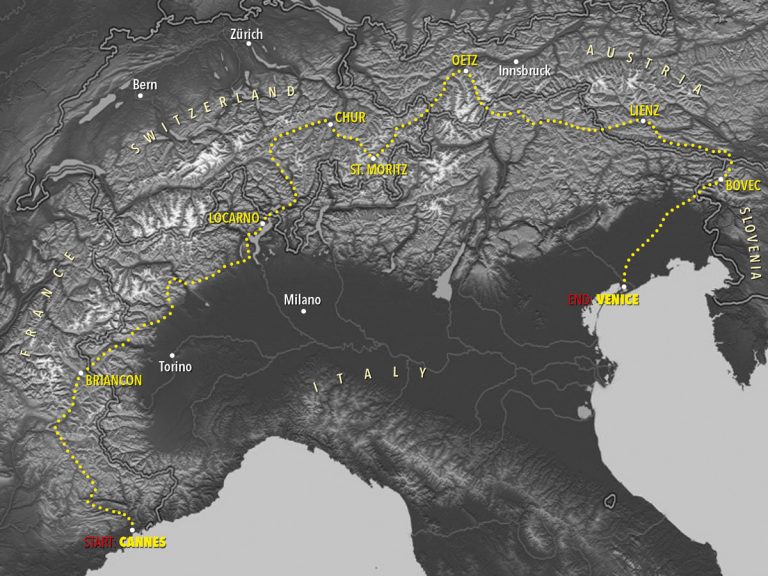
»I have no idea how many calories we burn but what I can tell is that our daily intake of food is impressive.«
Philip Baues
Kilometers and calories, pt II
Just in time for our arrival in the Verzasca Valley, on the swiss side of Lago Maggiore, the sun is shining again. The oh-so Ticino classic treats us well with turquoise-blue water and perfect flows. But now as the friends’ car is gone we face one well-known problem: How do we get back to our bikes after paddling? In our naive approach we thought we would just easily hitchhike but indeed three half-wet and half-naked dudes obviously deter most drivers from giving us a ride. So we end up running up the valley. I have no idea how many calories we burn but what I can tell is that our daily intake of food is impressive. A quick afternoon snack in Barcelonnette included one loaf of bread, one Camembert, one bag of chocolate croissants, one alp cheese, one salami, a grilled chicken and a family size pack of ice cream, roughly in this order. And yes, it was only three of us.
Winter break in June
From Ticino our trip leads us to Graubünden – still in Switzerland but we have to make it over 1915-meter high Lukmanier pass. Between the start in Biasca and the summit of the pass, you have to climb more than 1700 meters in altitude. But, after three weeks on the bike, our legs are strong and we no longer fear the arduous climbs. With music from the iPod, we clamber switchback after switchback – until again frozen water falls from the sky. The forecast for the next days says 4 °C and sleet.
At Vorderrhein and Inn, the railway runs just beside the paddling sections and allows relaxed shuttles. We even can take our kayaks in the train! It seems like our bodies entered the supercompensation during the break: We feel fitter than ever and in the blink of an eye we’re in the Ötztal—where I promptly black out. Either I overestimated that supercompensation or I have just been in the sun for too long. It is almost 40 °C now. The weather nothing but extremes on this trip: One day we are held back by the snow and the next we melt like butter in a pan. But we don’t want to complain, high water runs on the Ötz make up for all the sweat lost on the bike.
»Timmesljoch between the Otz Valley and South Tyrol marks the highest elevation of our trip – and people keep asking what the hell we are doing.«
Philip Baues
Schnaps for making mooneyes
Further up the valley the Timmelsjoch is waiting for us. This mountain pass between Austria and South Tyrol (Italy) marks the highest elevation of our trip and people keep asking what the hell we are doing. Telling them that we are coming from the Côte d’Azur brings us appreciative views but many tourists in their comfortable cars declare us crazy. But we have to admit that it is indeed strange how we sneak up the mountains to proudly announce that we are cycling from Cannes to Venice. The funniest of the folks explain that there is a more direct route – at the sea and without mountains. Haha.We don’t get ourselves into those discussions but rather enjoy the downhill to South Tyrol.
There we are still out of luck when it comes to water levels. Like in France everything is way too high. So head back to Austria for East Tyrol. To get into the Defereggen Valley we have to pass the Klammljoch, a steep and winding gravel track with gradient up to 16 percent. If you don’t bend over enough the front wheel rises, if you do so, the back wheel spins. Brilliant. Well, I guess it’s walking the bike from here.
Of course we fall behind our schedule but luckily there is a catered hut just below the ridge. We stop by, make eyes at the landlady and – boom! – we not only have a free schnapps but also a warm, dry place to stay for the night. Maybe it just was pity because of our heavy trailers, but we don’t care!
»The Isel is just the perfect river for any paddling ability. The lower sections above and below Lienz are perfect for beginners to have their first whitewater experiences.«
Philip Baues
On the next day we are in East Tyrol, adoptive home of whitewater legend Hans Mayer. He had also given us a ride to our starting point in Cannes a couple of weeks ago and now he takes good care of us here. Together we compete in a dragon boat race, celebrate my 30th birthday and paddle the Isel and the Drau. The Isel is just the perfect river for a whole paddling career: The lower sections above and below Lienz are perfect for beginners to have their first whitewater experiences. The higher you drive up the valley the more interesting things get. The “Isel Cataract” near a village called Huben is a serious piece of whitewater – especially in juicy summer flows. We catch a moderate level but still have a lot of fun in the pumping waters. And below the source of the Isel you can find steep and technical sections to paddle as well. Thank you Hans for having us!
In the La-Ola kayak shop in Lienz Jens buys some ear plugs. He insists that he needs them for paddling, I think Olaf is just snoring too loud and we spend most nights huddled up to one another under a small tarp. Every time we get under each other’s skin we remind ourselves of the privilege we have with this trip: Instead of sitting in the office back home, we cycle the Alps, go paddling and drink beer at the campfire.
»On the Canal Grande we soak up the flair of history-charged Venice. Then the waiter at St. Mark’s Square brings us back to reality by charging 11 € for a small beer.«
Philip Baues
Holiday at last
On the way to Slovenia we realize that even this trip will finally come to an end. On last time we will use our kayaks for what they made for, after that only the channels of Venice wait for us. Given that fact, we enjoy paddling in the crystal clear water of the Soča all the more. Even though the flow is really low we put in all the way up at the Koritnica and paddle down to the end of the big gorge. The main goal of this trip was finding not the highest waterfalls and the hardest whitewater but discovering simplicity, traveling by fair means, and having the overall Alps experience.
We set out for the final stage to Venice with full memory cards and unforgettable experiences.The whitewater kayaks are perfect to stroll around the city by water. On the Canal Grande and numerous other channels we soak in the flair of the history-charged city. Only the waiter at St. Mark’s Square brings us back to reality by charging 11€ for a small beer.
Then suddenly it’s over. We’re standing at the train station in Mestre, waiting for the night train to Munich. During the ride in the crowded train car, I wish myself back in the saddle and think about how I’d much rather be inhaling the fresh, clean air than the sweaty smell of the guy next to me. But only a few hours later and I am back in the lazy mode: Instead of biking the 60 kilometers back home to Augsburg, I take another train. Welcome back to reality. «««



